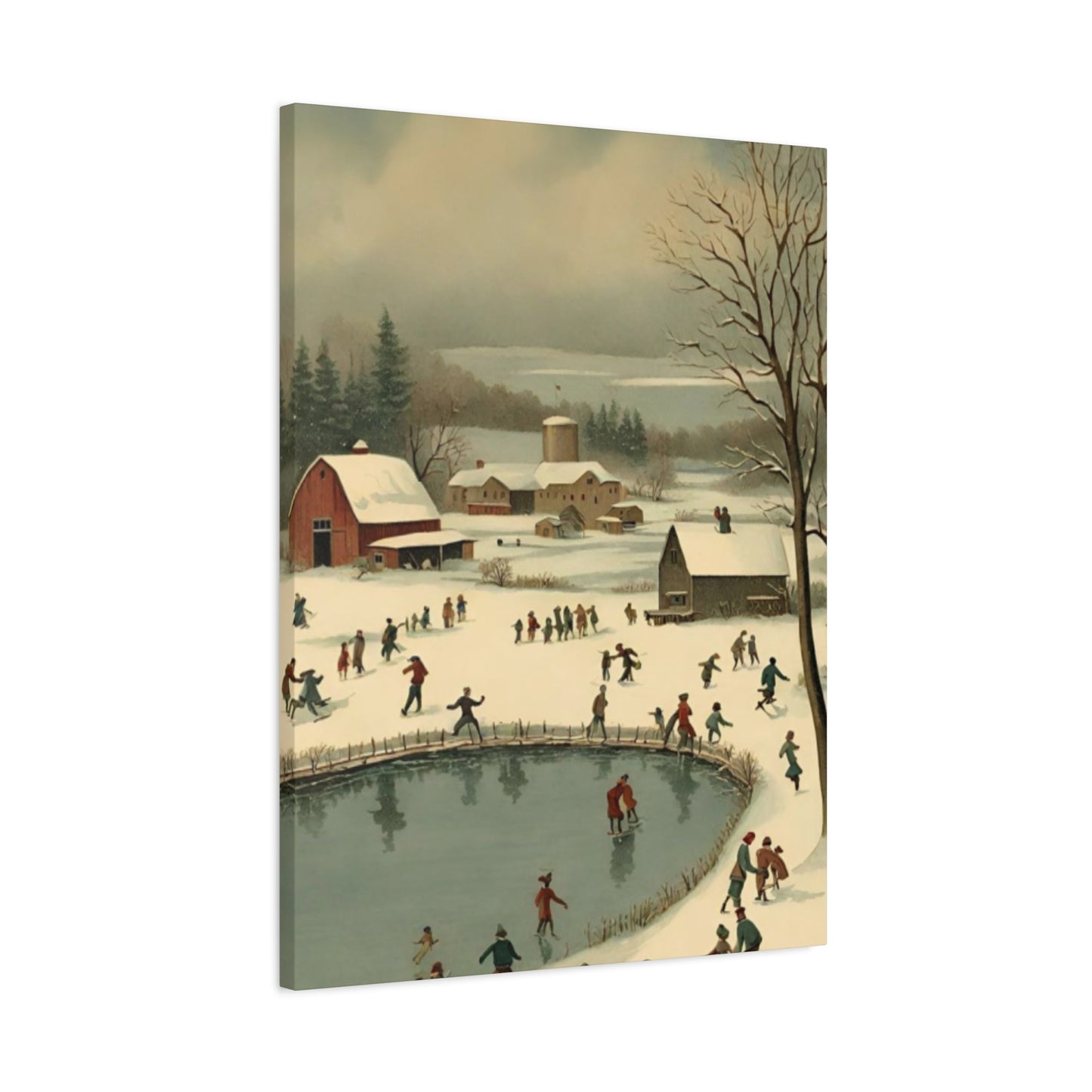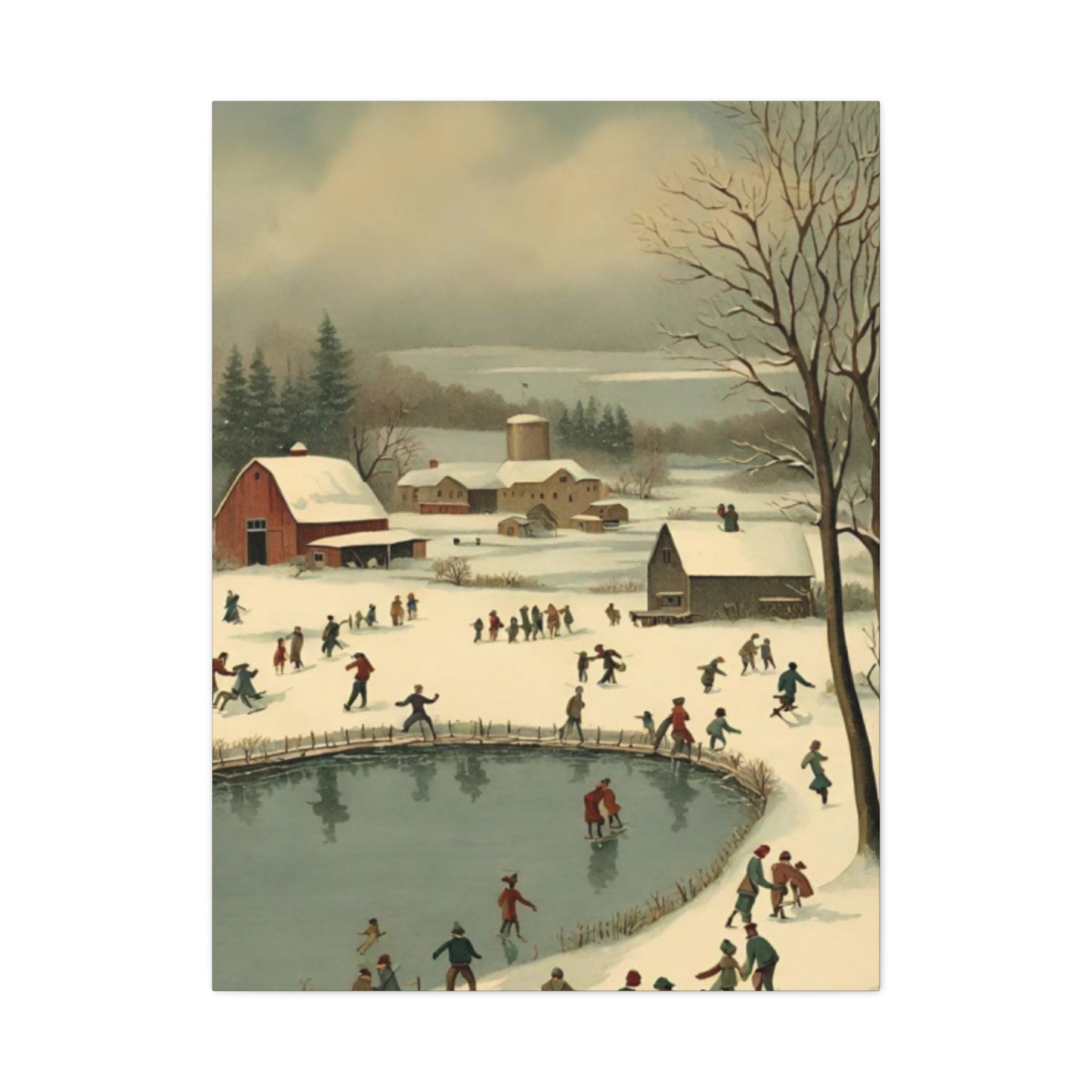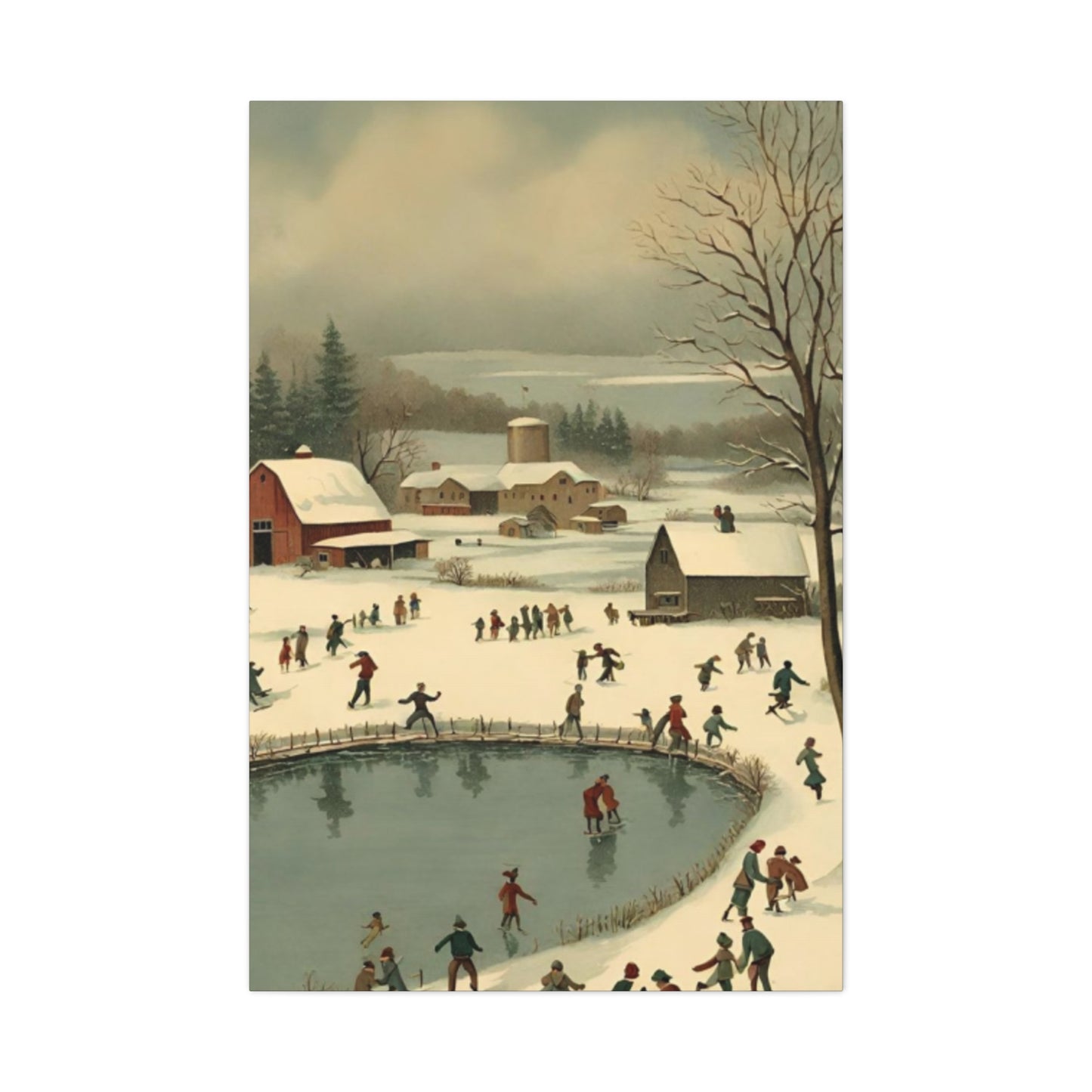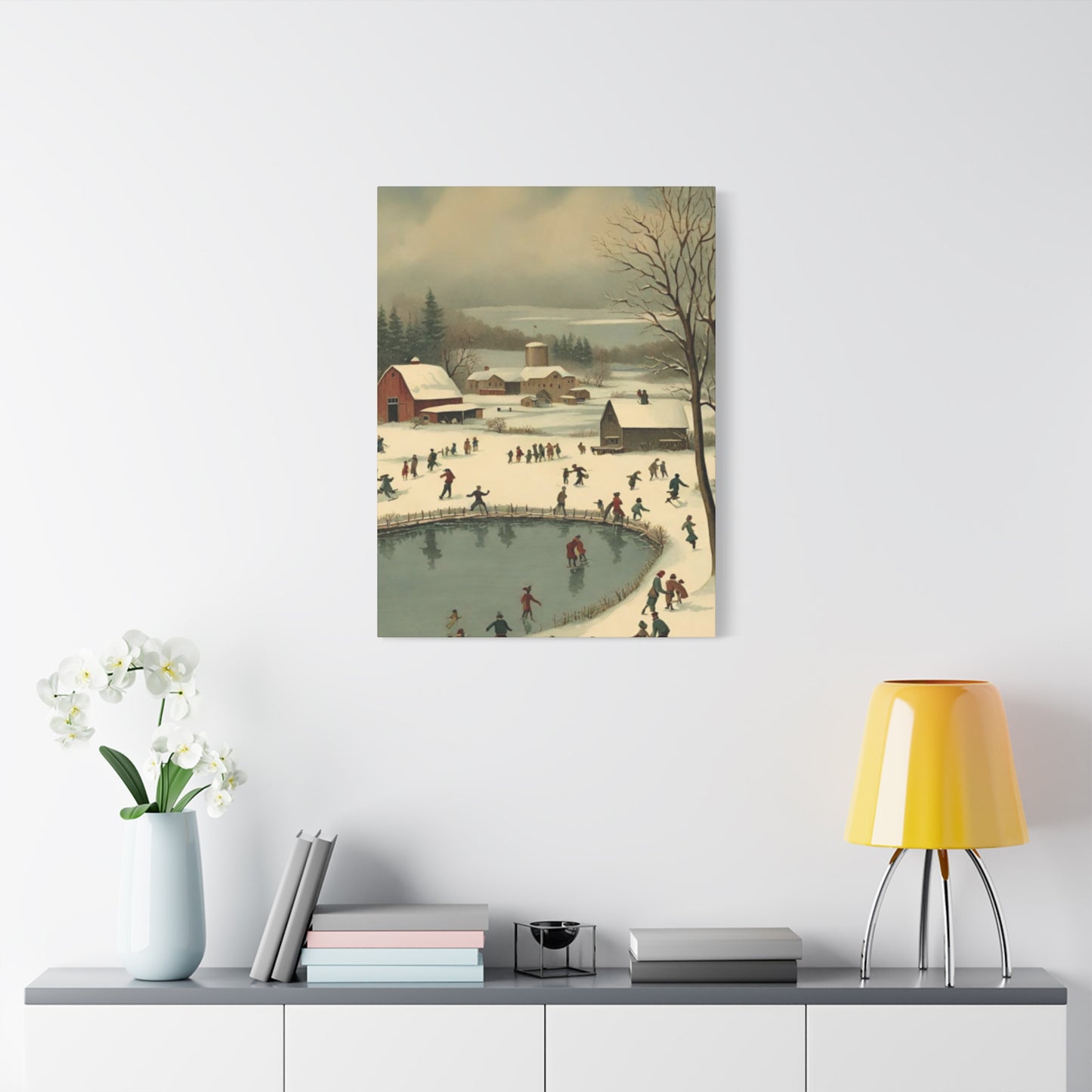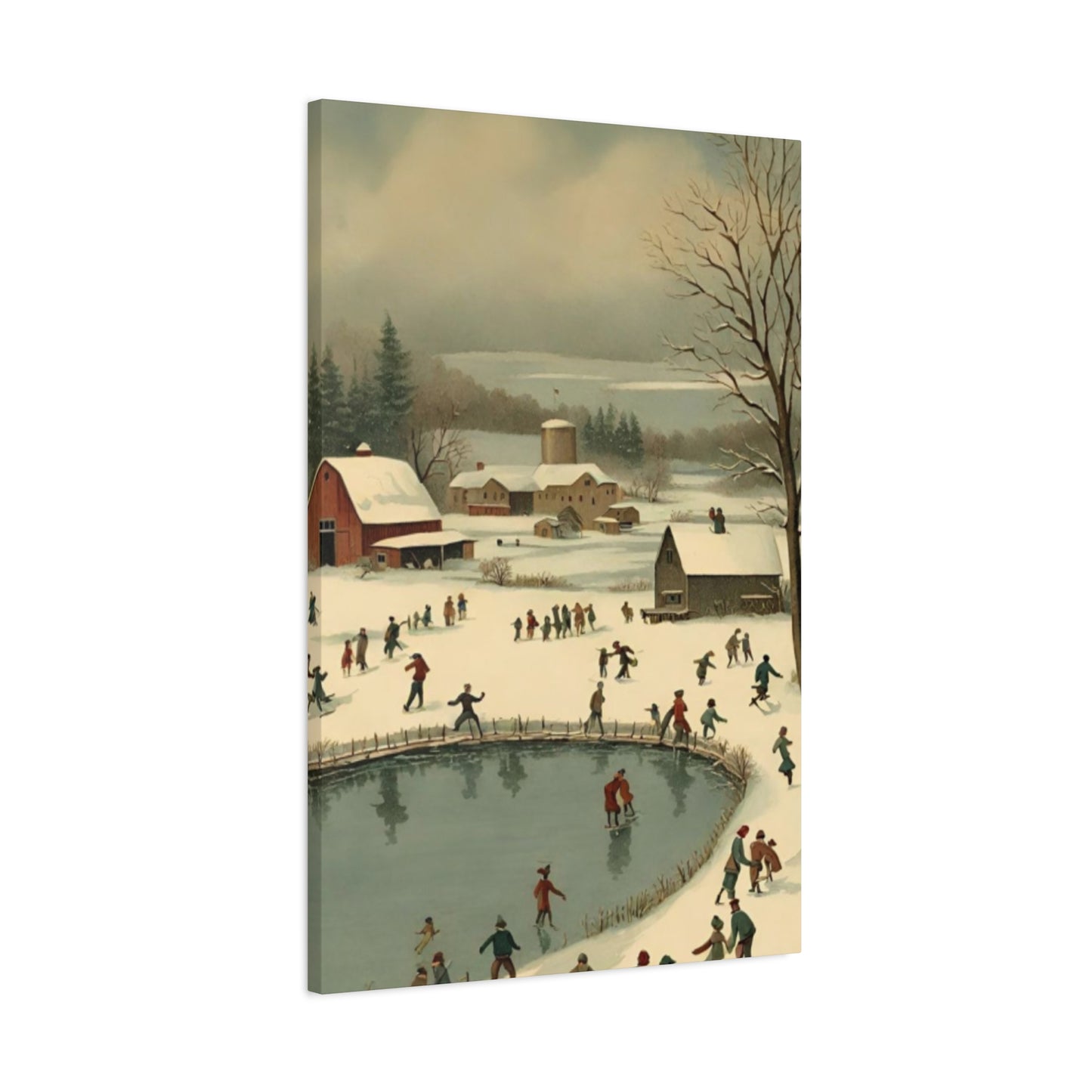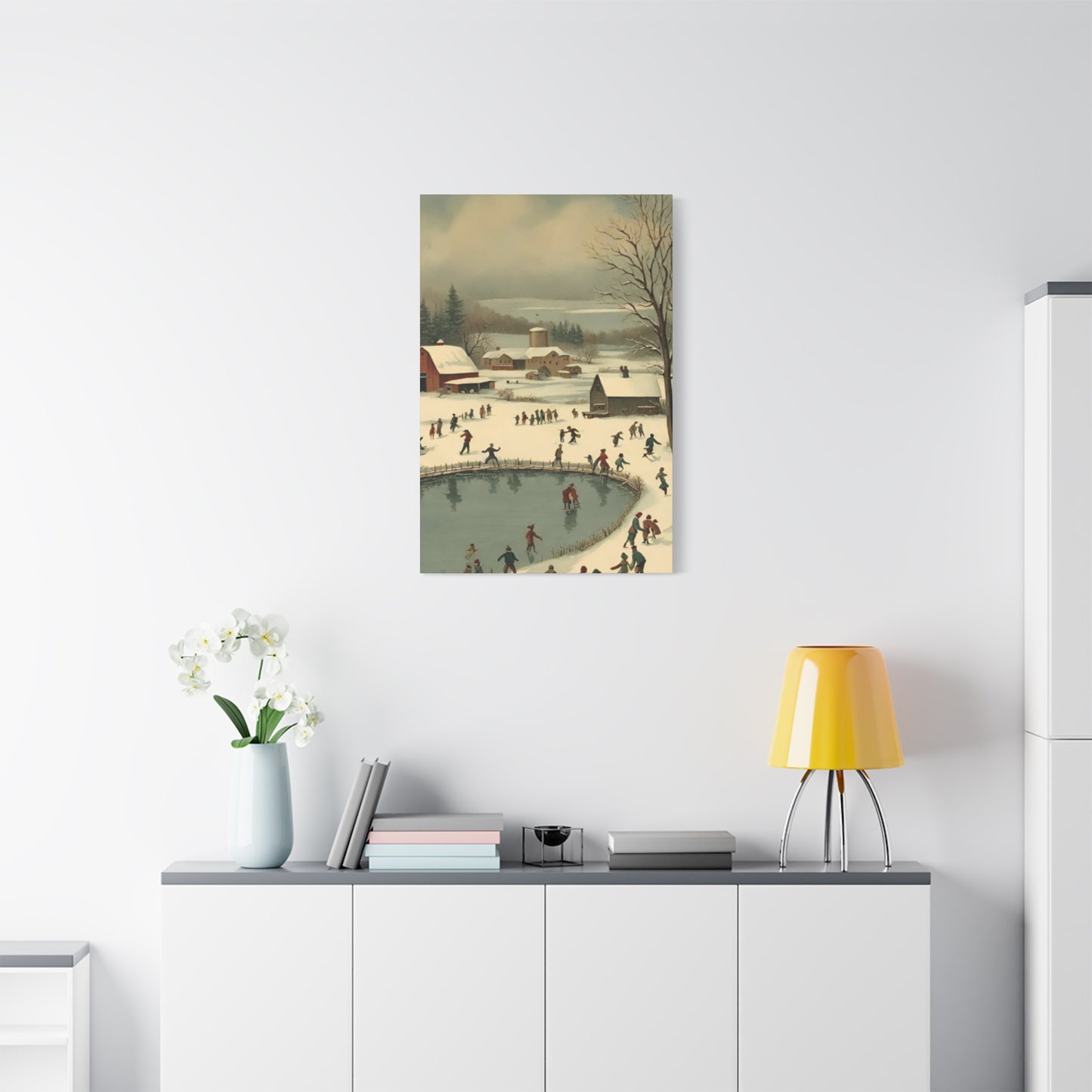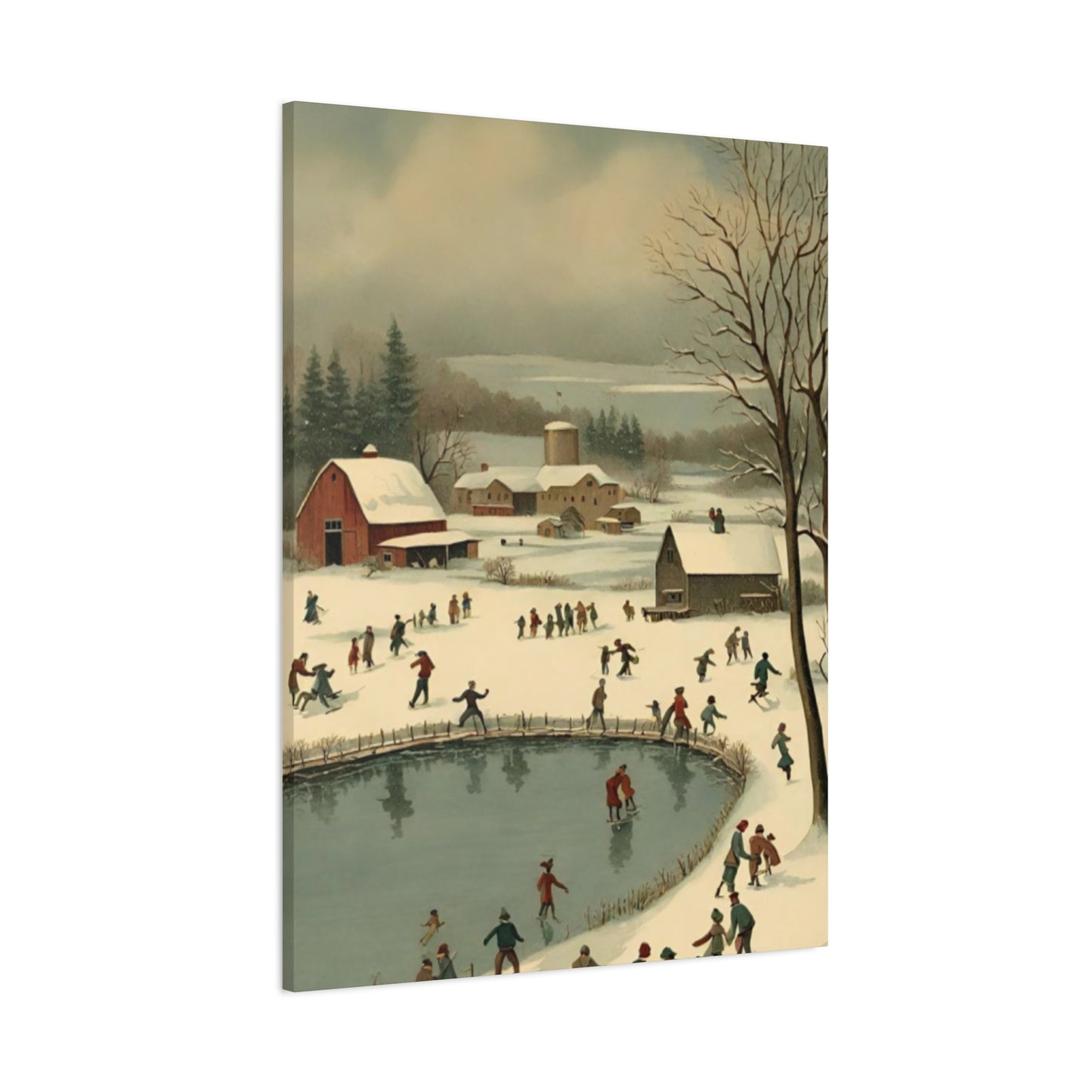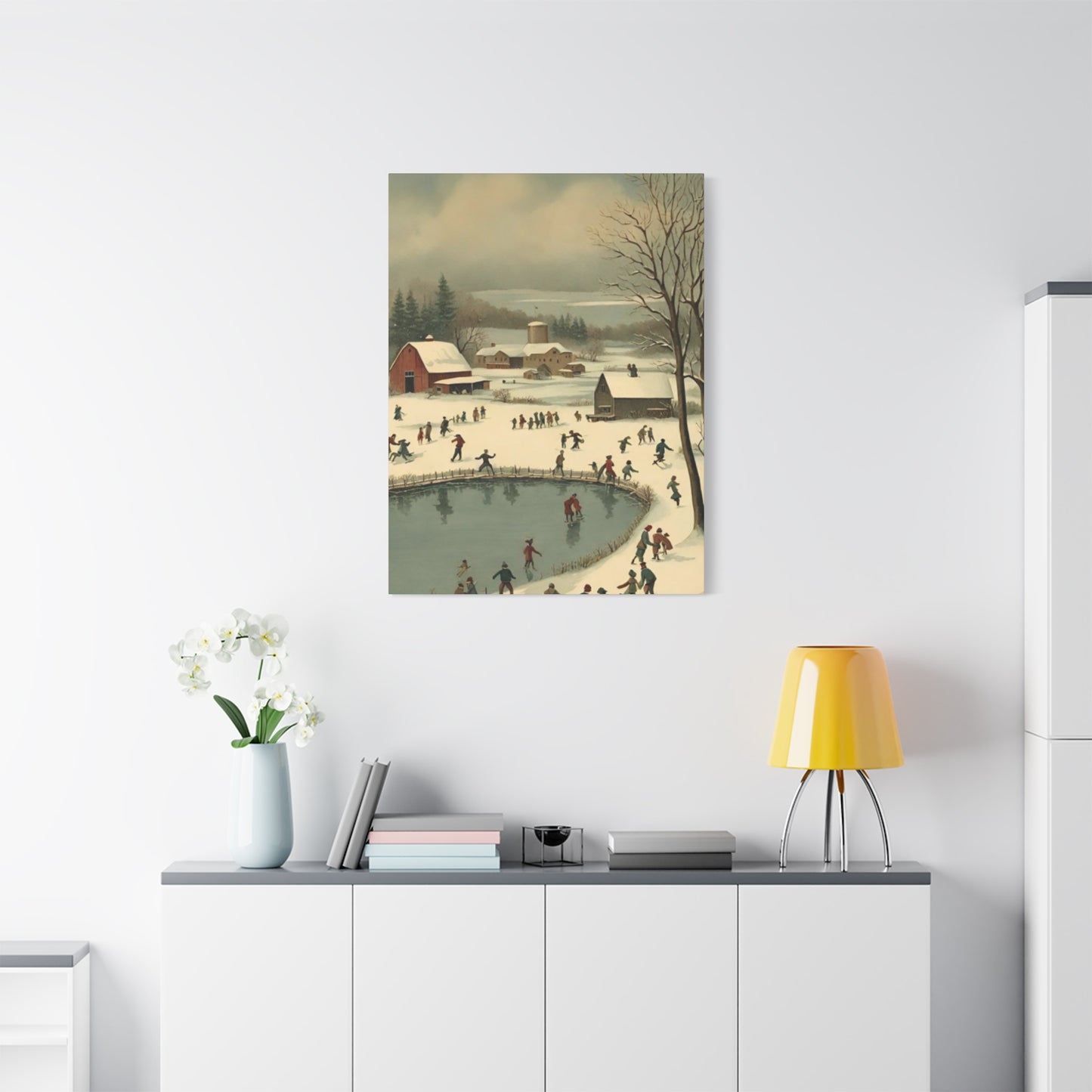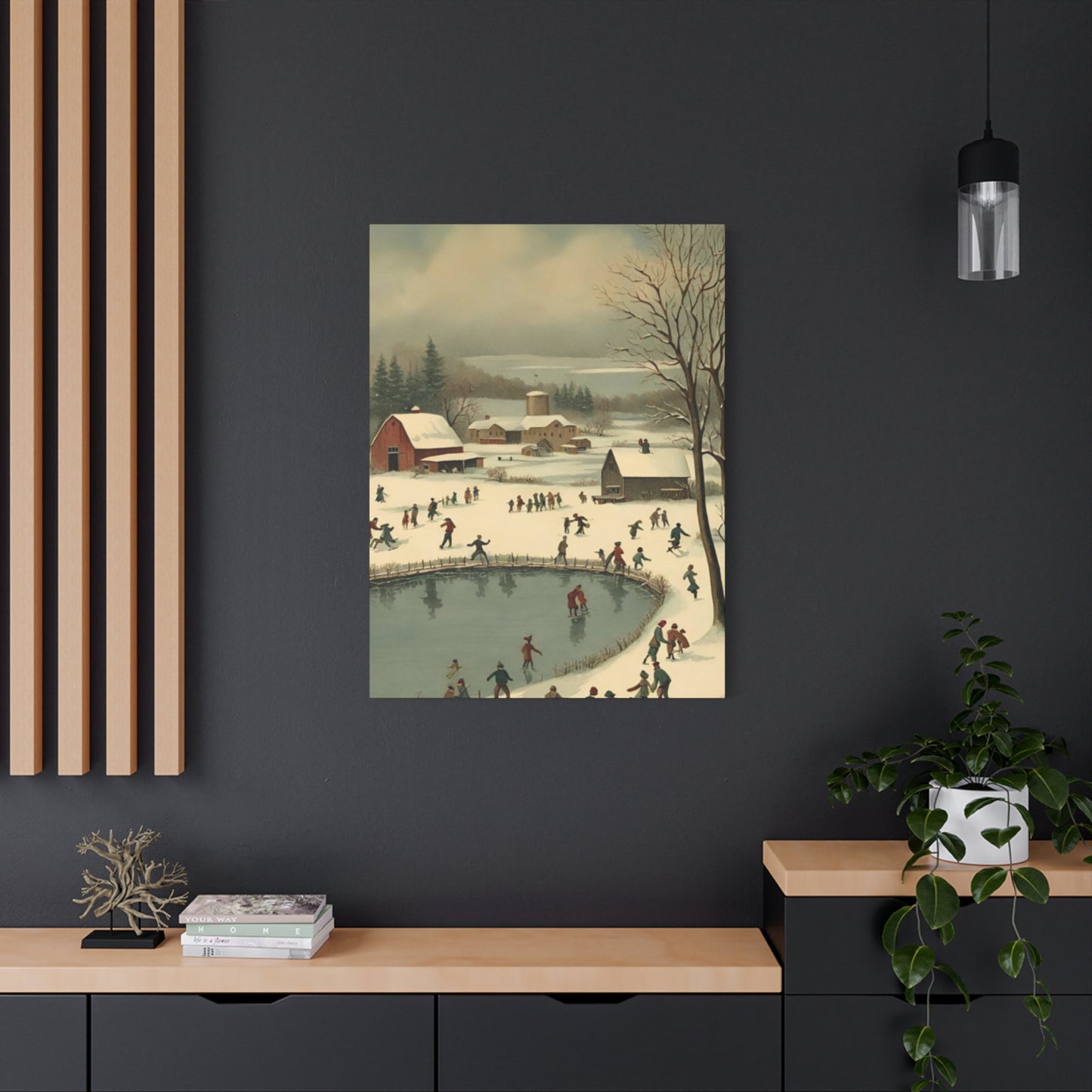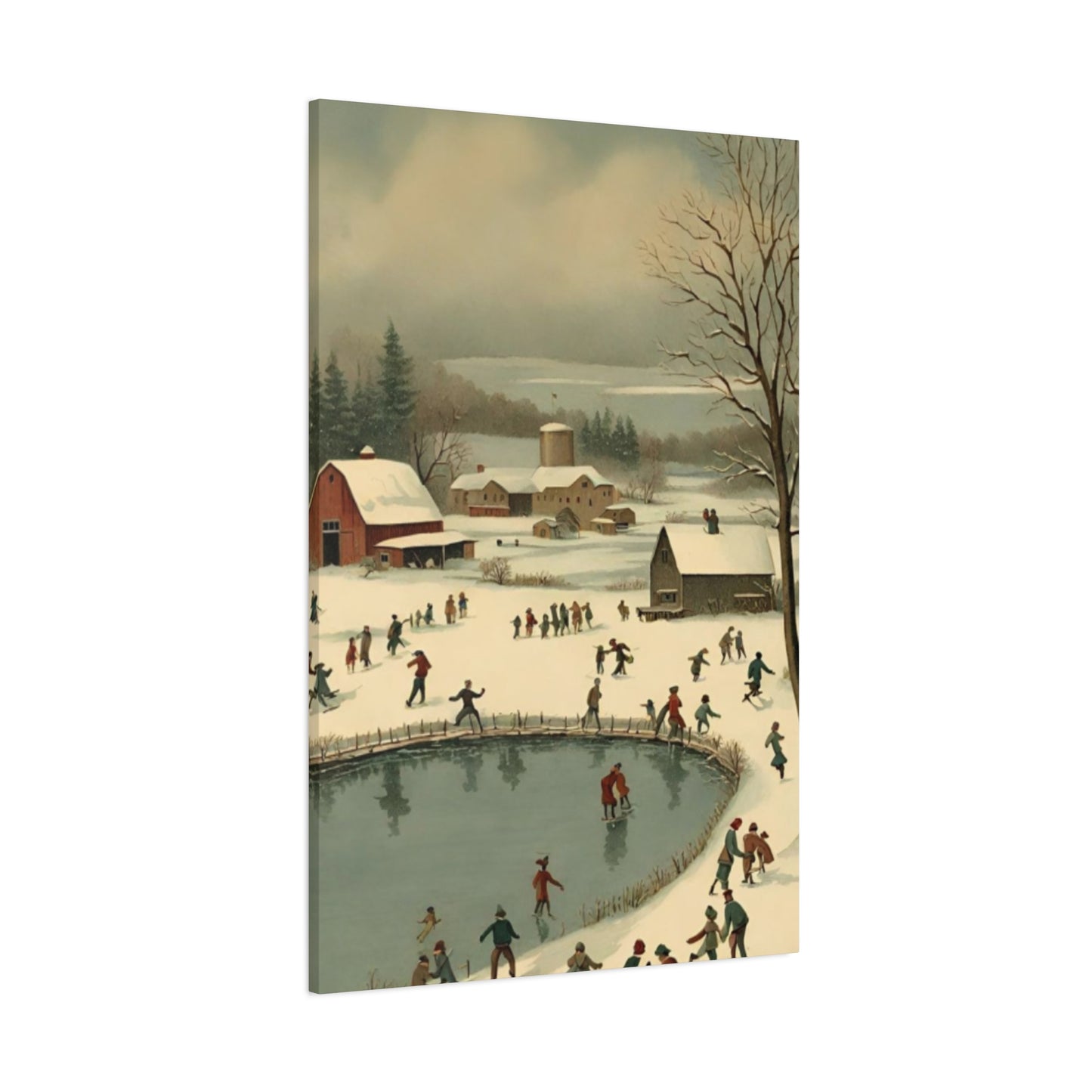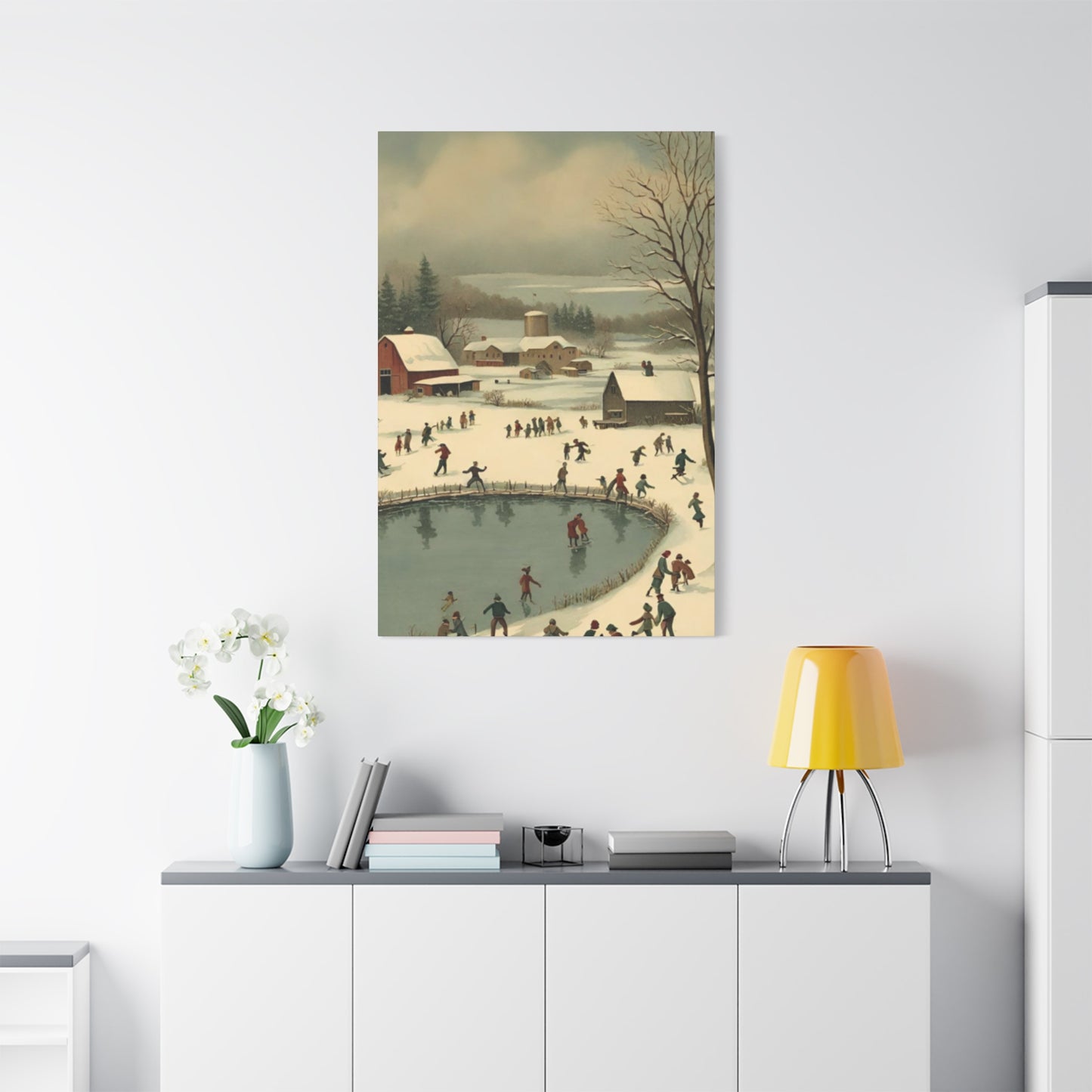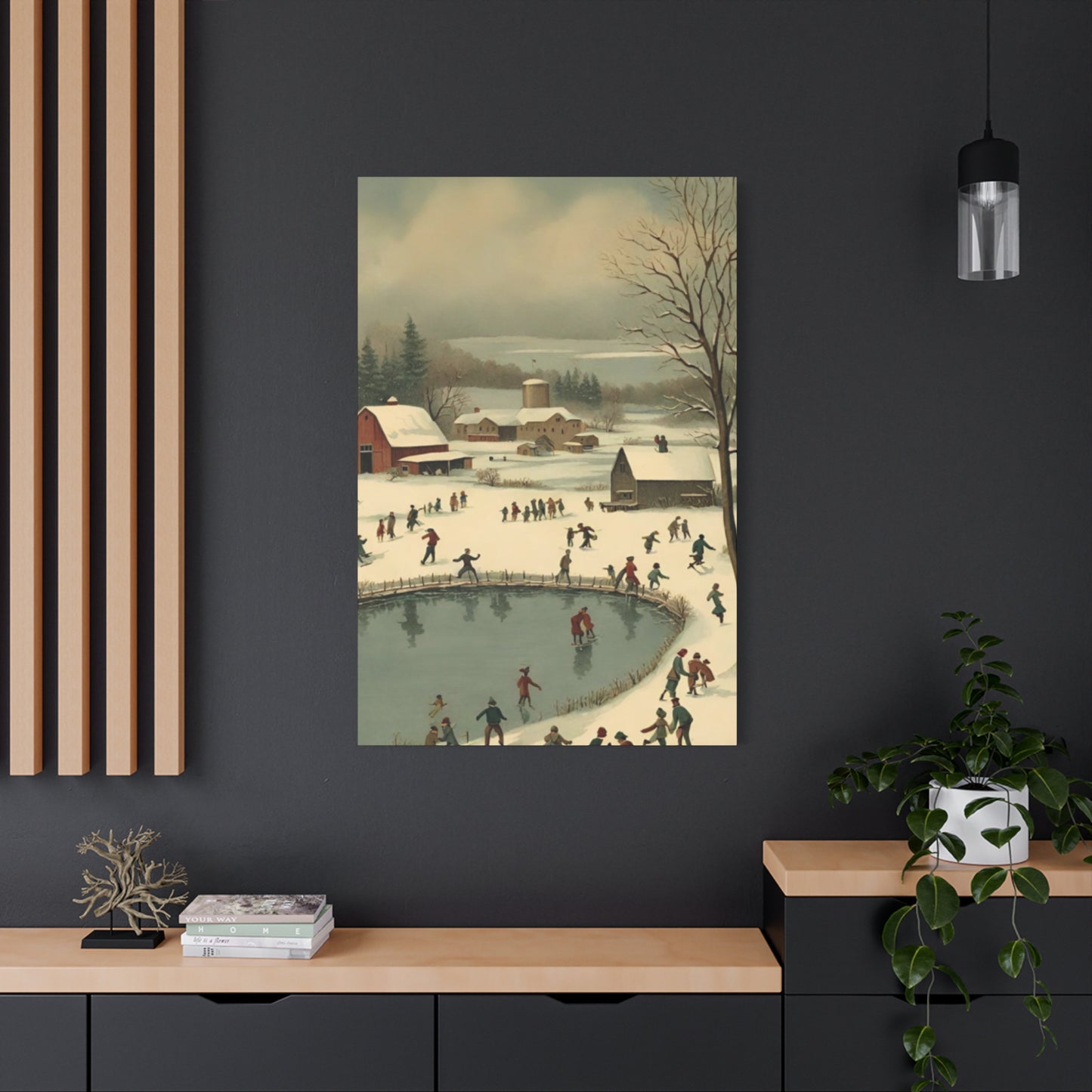Bringing Winter Joy Indoors: Decorating with People Enjoying Snow Wall Art
Winter has an undeniable charm that captures the imagination and warms the heart, even on the coldest days. The pristine beauty of snow-covered landscapes, the joy of people playing in the white powder, and the serene quiet that blankets everything in sight create moments worth preserving forever. Bringing these magical winter moments into your home through carefully selected canvas artwork transforms any space into a sanctuary of seasonal elegance and timeless beauty. Whether you are drawn to the simplicity of a snow-dusted pine forest or the vibrant energy of families building snowmen, winter-themed canvas prints offer endless possibilities for enhancing your interior design while celebrating the most wonderful time of the year.
The popularity of winter-themed canvas art has grown tremendously in recent years as homeowners and interior designers recognize the versatility and emotional impact these pieces can bring to various environments. From living rooms that need a refreshing focal point to children's bedrooms that could use a touch of whimsical wonder, snow scene artwork adapts beautifully to any setting. The crisp whites, cool blues, and occasional pops of warm color found in winter scenes create a sophisticated palette that complements both traditional and modern design aesthetics. More than just decoration, these pieces evoke feelings of nostalgia, peace, and joy, reminding us of cherished memories spent in the snow or inspiring dreams of future winter adventures.
When selecting canvas prints featuring people enjoying snowy landscapes, you are not just choosing artwork but inviting stories into your space. Each image captures a moment frozen in time, whether it is children laughing as they slide down a hill, couples walking hand in hand through a snow-covered park, or friends engaged in a spirited snowball fight. These scenes resonate with viewers on a personal level, often triggering happy memories of their own winter experiences. The human element in these artworks adds warmth and relatability to what might otherwise be a cold, distant scene, creating an emotional connection that purely landscape-focused pieces sometimes lack.
The technical quality of canvas prints has advanced significantly, allowing for incredibly detailed reproductions that capture every snowflake, shadow, and expression. Modern printing technology ensures that the textures of winter clothing, the sparkle of ice crystals, and the subtle gradations of light on snow are rendered with stunning clarity. This attention to detail means that even large-scale pieces maintain their visual impact without pixelation or loss of quality. The canvas material itself adds a tactile dimension to the artwork, with its slight texture mimicking the feel of traditional painted works while offering the durability and affordability that make canvas prints accessible to a wider audience.
Prints Celebrating Winter Activities on Canvas
Winter activity canvas prints capture the exhilarating spirit of the season through depictions of recreational pursuits unique to snowy conditions. These artworks celebrate the ways people embrace the cold rather than simply enduring it, transforming what could be harsh weather into opportunities for adventure, sport, and memorable experiences. From downhill skiing and snowboarding to ice fishing and winter hiking, these prints showcase the diverse ways humans interact with and enjoy winter environments. The action and movement inherent in these scenes create visual dynamism that energizes any space they occupy.
The appeal of winter activity artwork lies in its ability to capture decisive moments of action and emotion. A skier carving through powder creates elegant arcs that guide the viewer's eye through the composition. Children launching snowballs generate a sense of playful chaos and joy that brings smiles to everyone who sees it. Ice skaters gliding across a frozen pond demonstrate grace and skill while evoking memories of classic winter pastimes. These frozen moments of movement and expression give the artwork a narrative quality, inviting viewers to imagine the moments before and after what is depicted, essentially telling a story through a single image.
Color usage in winter activity prints often differs from more serene snow landscapes. The gear and equipment associated with winter sports introduce bold, saturated colors that pop dramatically against white snow and gray skies. Neon ski jackets, brightly colored snowboards, and vivid toboggans create strong visual contrast that makes these pieces particularly effective in spaces that need an injection of energy and color. This vibrant palette works especially well in contemporary and eclectic interiors where color blocking and bold statements are welcomed design elements.
The technical aspects of depicting motion in still artwork require skill and artistic understanding. Successful winter activity prints use techniques like motion blur, directional lines, and strategic positioning to convey speed and movement. The spray of snow kicked up by a snowboarder's turn, the arc of a thrown snowball, or the lean of a speed skater's body all communicate action and energy. When selecting these pieces, look for artworks that effectively capture this sense of motion, as these will maintain visual interest and continue to engage viewers over time.
Different winter activities carry different cultural and emotional associations that influence their impact as artwork. Skiing and snowboarding often symbolize luxury, adventure, and athletic prowess, making them popular choices for homes in mountain regions or for individuals who identify with winter sports culture. Ice skating, particularly when depicted in urban or community settings, evokes nostalgia and represents accessible winter enjoyment that many people have experienced. Sledding and snow play scenes resonate universally, as these activities require no special equipment or training, representing pure, uncomplicated winter joy.
Decorative Winter Day Artwork for Walls
Decorative canvas art capturing snowy day scenes brings the tranquil beauty of winter weather indoors, creating peaceful and elegant atmospheres in any room. These pieces focus on the aesthetic qualities of snow itself rather than primarily on human activities, though figures may appear as secondary elements within the composition. The soft, diffused light characteristic of overcast winter days, the way snow accumulates on tree branches and rooftops, and the muted color palette of a world covered in white all contribute to the serene, contemplative mood these artworks establish.
The appeal of snowy day décor lies in its ability to create calm, neutral backdrops that complement rather than compete with other design elements in a room. Unlike artwork featuring bold colors or busy compositions, these pieces provide visual rest and allow the eye to relax. This makes them excellent choices for spaces where reducing stress and promoting relaxation are priorities, such as bedrooms, bathrooms, and quiet sitting areas. The predominantly white and gray color schemes also offer tremendous decorating flexibility, working harmoniously with virtually any color palette you might already have established in your home.
Texture plays a particularly important role in snowy day canvas prints. The best pieces convey the varied textures of a snow-covered landscape, from the smooth, unblemished surface of fresh snowfall to the rougher, dimpled appearance of older snow. The way light interacts with these different textures creates subtle shadows and highlights that add depth and dimension to what could otherwise be a flat, monochromatic scene. Quality canvas prints reproduce these textural details effectively, and the canvas material itself contributes additional tactile interest that enhances the overall sensory experience of the artwork.
Seasonal and geographical associations influence how snowy day artwork is perceived and appreciated. For those living in regions with harsh winters, these images might represent the reality of daily life for several months each year, offering a chance to appreciate beauty in familiar surroundings. In warmer climates, the same artwork provides a window into a different world, offering visual coolness and the novelty of an environment quite different from what exists outside. This geographical dimension means that snowy day décor can serve different psychological purposes depending on where you live and your personal relationship with winter weather.
The inclusion or exclusion of human elements in snowy day artwork significantly affects its emotional tone and narrative quality. Pieces featuring no people at all emphasize the silence and solitude of winter landscapes, creating contemplative moods that border on meditative. A single figure, perhaps walking through the snow or standing still in observation, adds a human scale and suggests personal reflection or solitary enjoyment of nature. Multiple figures introduce social elements and shared experiences, though these typically remain secondary to the overall landscape in this category of artwork.
Architectural elements frequently appear in snowy day décor, with snow-covered buildings, barns, churches, and houses adding structural interest to compositions. These human-made structures, transformed by snow, create appealing contrasts between geometric forms and organic snowfall patterns. Rural settings with rustic barns and farmhouses evoke nostalgia and simpler times, while urban scenes showing snow-covered streets and buildings capture a different kind of beauty unique to winter in cities. The choice between rural and urban settings should reflect your personal preferences and lifestyle.
Time of day dramatically affects the mood and color palette of snowy day artwork. Midday scenes feature bright whites and clear details, showcasing the crispness and clarity that characterizes fresh snow under adequate lighting. Dawn and dusk scenes introduce warmer tones as the low sun casts golden or pink hues across the snow, creating romantic and ethereal atmospheres. Night scenes, particularly those featuring street lamps or house lights glowing against the darkness, offer dramatic contrast and intimate warmth. Consider which time of day atmosphere best suits the room where you plan to display the artwork.
Imagery of Individuals Appreciating Snowy Environments
Canvas prints depicting people truly enjoying and appreciating snow capture the emotional and experiential dimensions of winter in ways that landscape-only pieces cannot. These artworks focus on the human response to snow, showcasing expressions of wonder, joy, contentment, and connection that arise when people engage with winter weather. Unlike action-oriented winter sports imagery, these pieces emphasize contemplation, gentle interaction, and the simple pleasure of being present in a snowy environment. They celebrate snow as a source of beauty and happiness rather than merely a setting for activities.
The emotional authenticity captured in these images creates powerful connections with viewers. A child's face lit up with wonder at catching snowflakes on their tongue, a couple sharing a quiet moment during a winter walk, or a group of friends laughing together in a snow-covered park all convey genuine human emotion that resonates universally. These unguarded moments of happiness and connection remind viewers of their own positive winter experiences and can even shift perspectives for those who typically view snow as merely an inconvenience. The psychological impact of surrounding yourself with imagery showing positive human experiences should not be underestimated.
Generational and demographic representation in these artworks influences their relatability and appeal. Pieces showing children experiencing snow tap into parental emotions and appeal to families, while also evoking nostalgia in older viewers remembering their own childhood snow experiences. Artwork featuring young adults and couples often carries romantic connotations, representing winter dates, adventures, and milestone moments. Images including elderly individuals enjoying snow demonstrate that winter appreciation spans all ages and can serve as touching reminders of life's continuity and enduring simple pleasures.
The balance between figures and landscape in these compositions requires careful attention. The most effective pieces integrate people seamlessly into the winter environment rather than simply placing them against a snowy backdrop. This integration is achieved through elements like snow clinging to clothing, breath visible in cold air, footprints trailing behind figures, and body language reflecting response to cold temperatures. These details create authenticity and help viewers mentally place themselves in the scene, enhancing the artwork's immersive quality.
Cultural and geographical diversity in snow appreciation artwork broadens its appeal and educational value. Winter experiences vary dramatically around the world, from the first tentative snow of temperate regions to the deep accumulations of arctic areas. Artwork showing diverse people from various cultural backgrounds enjoying snow celebrates the universal appeal of this natural phenomenon while acknowledging different perspectives and experiences. This diversity makes these pieces appropriate for increasingly multicultural societies and demonstrates that winter joy knows no boundaries.
Clothing and costume details in these artworks serve both practical and aesthetic functions. Realistically depicted winter clothing including coats, hats, scarves, and gloves adds authenticity and helps viewers relate to the cold temperatures implied by the snow. These garments also provide opportunities for color, pattern, and texture that enliven the composition and prevent it from becoming too monochromatic. Historical pieces featuring period-appropriate winter clothing add nostalgic or vintage appeal, while contemporary clothing keeps the artwork feeling current and relatable.
Impressive Winter Artwork Suitable for Display
Gallery-worthy winter canvas prints elevate interior spaces through artistic excellence, sophisticated composition, and museum-quality reproduction that demands attention and admiration. These pieces transcend simple decoration to become conversation starters and focal points that define entire rooms. Whether featuring snowy landscapes, winter activities, or seasonal scenes, these artworks demonstrate the kind of quality and aesthetic impact that gallery curators and serious collectors seek. Investing in gallery-worthy pieces means selecting artwork that maintains its visual and emotional impact over many years while potentially appreciating in value.
The characteristics that distinguish gallery-worthy artwork from standard decorative prints include superior composition, exceptional technical execution, and distinctive artistic vision. Composition refers to how elements are arranged within the frame to guide the viewer's eye, create balance, and establish hierarchy among visual components. The rule of thirds, leading lines, strategic use of negative space, and thoughtful framing all contribute to professional-level composition. Technical execution encompasses focus, exposure, color accuracy, and in painted works, brushwork and application. Artistic vision represents the unique perspective or style that makes a piece memorable and distinguishes it from countless similar subjects.
Subject matter selection for gallery-worthy winter artwork often focuses on either universal themes that resonate broadly or highly specific moments that capture unique beauty. Universal themes like the silence of a snow-covered forest, the joy of children playing in snow, or the stark beauty of winter trees against a gray sky connect with viewers regardless of their personal experiences. Unique moments might include unusual weather conditions, rare wildlife interactions in winter, or unexpected juxtapositions that surprise and delight. Both approaches can yield gallery-quality results when executed with skill and sensitivity.
Size considerations for gallery-worthy pieces typically skew larger than standard décor items, as substantial dimensions create the impact and presence expected from significant artworks. Large canvases command attention and anchor spaces, making them appropriate for prominent walls in living rooms, dining areas, or entry halls. However, gallery-worthy quality can certainly exist in smaller formats, particularly in intimate works that reward close viewing and reveal details not apparent from a distance. The key is that the size feels intentional and appropriate to the subject rather than arbitrary or limited by production constraints.
Limited edition status and artist signatures add value and collectibility to gallery-worthy winter canvas prints. Limited editions create scarcity that enhances desirability and investment potential, while artist signatures authenticate the work and establish a direct connection between creator and owner. Numbered editions allow collectors to know exactly how many copies exist, with lower numbers often commanding premium prices. For those building serious art collections, these factors matter significantly, though they may be less important to those primarily seeking beautiful additions to their homes.
Framing and presentation dramatically affect how gallery-worthy artwork is perceived and how effectively it integrates into refined interiors. While many canvas prints are designed for gallery wrap presentation, where the image continues around the edges and no frame is necessary, true gallery-worthy pieces often benefit from professional framing. Museum-quality frames complement without competing, using materials and finishes that enhance the artwork while providing protection. Shadow boxes, floating frames, or traditional framed presentations each offer different aesthetic effects that should harmonize with both the artwork and the surrounding décor.
Winter-Themed Canvas for Main Living Areas
Living room canvas art featuring snow scenes transforms these central gathering spaces into showcases of seasonal beauty and personal style. As the room where families spend the most time together and where guests are typically entertained, living rooms benefit from artwork that makes strong visual statements while creating welcoming, comfortable atmospheres. Winter-themed pieces offer unique advantages for living rooms, providing cool, calm color palettes that balance warmer furnishing tones while introducing the elegance and beauty of the season. The right snow canvas can anchor an entire living room design, establishing the color scheme, mood, and aesthetic direction for all other décor decisions.
Scale appropriate to living room proportions ensures that snow canvas artwork makes the intended impact without overwhelming or underwhelming the space. Large living rooms with high ceilings and substantial furniture require correspondingly large artwork to maintain visual balance. A single oversized canvas depicting a sweeping winter landscape can create a window-like effect, opening the room to expansive snowy vistas. Multiple medium-sized canvases arranged in a gallery wall configuration offer flexibility and visual interest while filling significant wall space. Smaller living rooms benefit from more modest sizing that complements rather than dominates, with dimensions proportional to furniture and wall space.
Placement within the living room significantly affects how snow canvas artwork influences the space and how viewers engage with it. Above the sofa represents the most traditional and often most effective placement, creating a natural focal point that faces seating arrangements and draws the eye. Fireplace mantels offer another prime location, with winter scenes above the hearth creating thematic harmony between the warmth of the fire and the coolness of the snow imagery. Alternative walls, such as those visible from entryways or behind seating areas, can create surprise elements and ensure the artwork is visible from multiple vantage points throughout the room.
Color coordination between snow canvas artwork and living room décor creates cohesion while allowing for creative expression. The cool blues, whites, and grays inherent in winter scenes complement a wide range of color schemes, from neutral palettes to bold, saturated hues. For rooms featuring warm tones like terracotta, burnt orange, or deep reds, winter artwork provides refreshing contrast that prevents the space from feeling too heavy or monotonous. In rooms already featuring cool tones, winter scenes extend and reinforce the color palette, creating serene, spa-like atmospheres. Accent colors within the artwork, perhaps from clothing or sunset lighting, can be echoed in throw pillows, blankets, or decorative objects to tie the room together.
Style consistency between furniture and artwork ensures that snow canvases enhance rather than clash with the overall design aesthetic. Traditional living rooms with classic furniture styles, ornate details, and rich fabrics pair beautifully with painted or illustrated winter scenes that have timeless, classic qualities. Contemporary spaces featuring clean lines, minimalist furniture, and modern materials benefit from photographic snow prints or abstract winter interpretations that share their modern sensibility. Transitional living rooms that blend traditional and contemporary elements enjoy tremendous flexibility, accommodating a wide range of winter artwork styles from realistic to abstract.
Simplified Winter Canvas for Minimalist Spaces
Minimalist design philosophy prioritizes simplicity, clean lines, and intentional choices that eliminate excess while celebrating essential elements. Winter wall prints designed for minimalist interiors embrace these principles, featuring spare compositions, limited color palettes, and emphasis on negative space that aligns perfectly with minimalist aesthetics. Snow scenes naturally lend themselves to minimalist interpretation, as winter landscapes often feature expansive areas of unbroken white punctuated by simple forms like lone trees, distant mountains, or solitary figures. These characteristics make winter-themed artwork surprisingly well-suited to minimalist spaces.
Color restraint represents a defining characteristic of minimalist winter prints, with most pieces limiting themselves to a handful of carefully selected hues. Monochromatic compositions in shades of white, gray, and black offer the ultimate in minimalist appeal, creating sophisticated, gallery-like atmospheres that never feel cluttered or busy. The subtle gradations between these tones provide depth and interest without introducing the visual complexity that multiple colors create. Some minimalist winter prints introduce a single accent color, perhaps a muted blue for shadows or a warm beige for hints of bare ground, adding just enough variation to prevent starkness while maintaining overall restraint.
Compositional simplicity in minimalist winter wall art focuses viewer attention on a single subject or concept rather than multiple competing elements. A solitary tree standing in a snow-covered field, a simple geometric building dusted with snow, or a single set of footprints trailing across an otherwise pristine landscape all exemplify this approach. These uncomplicated compositions create powerful images through what they exclude as much as what they include, embracing the Japanese aesthetic concept of ma, or meaningful emptiness. This restraint allows viewers to appreciate subtle details and find their own meaning in the simplicity presented.
Restful Spaces Enhanced with Snowy Scene Artwork
Bedroom environments benefit tremendously from carefully selected snow scene canvas prints that promote relaxation, tranquility, and restful sleep. As personal sanctuaries dedicated to rest and renewal, bedrooms require artwork that soothes rather than stimulates, creating calming atmospheres conducive to winding down at day's end. Winter imagery naturally supports these goals through cool color palettes, quiet compositions, and associations with peace and stillness. The best bedroom snow scenes avoid busy, energetic compositions in favor of serene landscapes, gentle snowfall, and contemplative moments that ease viewers toward relaxation.
Color psychology plays a crucial role in bedroom snow scene selection, as colors directly influence mood and physiology. The blues and whites dominant in winter imagery have calming effects, lowering heart rate and blood pressure while promoting feelings of serenity. These cool tones create visual coolness that can make rooms feel more spacious and airy, particularly beneficial in smaller bedrooms. Warm accents within winter scenes, such as golden sunset light or glowing windows, add psychological warmth without overwhelming the calming base palette. This balance between cool serenity and warm comfort creates ideal bedroom atmospheres.
Subject matter in bedroom snow art should emphasize peaceful, static scenes rather than active, energetic compositions. Gently falling snow, quiet forests blanketed in white, or solitary figures in contemplative poses all contribute to the restful atmosphere bedrooms require. Avoid scenes depicting vigorous activities, crowds, or anything suggesting noise or chaos. Even beautiful winter scenes can be too stimulating for bedroom environments if they depict action or drama. The goal is artwork that viewers can gaze upon while relaxing in bed without feeling mentally or emotionally activated.
Placement within bedrooms significantly affects how snow scene artwork contributes to the space and bedtime routines. Above the bed represents the traditional choice, creating a focal point visible from the doorway while providing something pleasant to view when sitting up in bed. However, some sleep experts suggest avoiding busy or stimulating artwork directly above the bed, as it may be the last thing seen before sleep and first thing upon waking. Alternative placements on walls facing the bed allow for enjoyment while relaxing in bed without positioning artwork directly overhead. Bedrooms with seating areas benefit from placing winter art in those zones, creating distinct relaxation spaces separate from the sleeping area.
Professional Environments with Winter Canvas Displays
Office spaces benefit from thoughtfully selected snow canvas artwork that creates professional atmospheres while avoiding sterile, impersonal feelings. Whether home offices or corporate workplaces, these environments require décor that projects competence and success while remaining welcoming and inspiring. Winter scenes offer unique advantages for professional spaces, combining sophisticated color palettes with subject matter that suggests clarity, purity, and fresh perspectives. The right snow canvas can subtly influence workplace mood and productivity while making positive impressions on clients and colleagues.
Home office artwork selection differs significantly from corporate spaces, as personal preference takes precedence and individuality can be more freely expressed. Working from home allows professionals to surround themselves with imagery that personally motivates and inspires, whether that is adventurous winter sports scenes that energize or peaceful winter landscapes that calm and center. The key is choosing winter artwork that supports your specific work style and needs. Those requiring sustained focus benefit from serene, uncomplicated scenes that do not distract, while those engaged in creative work might draw inspiration from more dynamic or unusual winter imagery.
Corporate office snow canvas selections must balance personal expression with professional standards and company culture. Conservative industries like finance and law typically favor traditional, understated winter landscapes that suggest stability and timelessness. Creative industries enjoy more freedom, with contemporary or artistic winter interpretations fitting naturally into progressive workplace cultures. The size and prominence of businesses also influences choices, with large corporations often preferring generic appeal that offends no one, while smaller companies can take more risks with distinctive, memorable pieces that reflect unique identities.
Client-facing areas including reception areas, conference rooms, and executive offices receive particular attention regarding artwork selection. Winter canvas prints in these spaces contribute to first impressions and ongoing perceptions of the company. Sophisticated, gallery-quality pieces suggest success, attention to detail, and refined taste. Local winter scenes can create regional pride and connection with community-based clients. Abstract or contemporary winter interpretations position companies as forward-thinking and innovative. The specific message you want to communicate should guide artwork selection in these critical spaces.
Productivity and mood effects of office snow canvas artwork warrant consideration, as workplace décor influences employee performance and satisfaction. Studies show that nature imagery, including winter landscapes, reduces stress and improves focus compared to blank walls or urban scenes. The psychological distance and perspective offered by expansive winter vistas can help workers mentally reset during brief breaks from concentrated work. Cool color palettes promote calm and reduce anxiety, while hints of warmth within winter scenes prevent feelings of coldness or sterility. These subtle influences accumulate over time, contributing to workplace wellbeing.
Striking Centerpieces Using Winter Wall Art
Creating bold focal points with snow canvas artwork transforms rooms from merely decorated to thoughtfully designed, with clear visual hierarchies that guide attention and establish atmosphere. Focal point artwork serves as the anchor around which all other design elements orbit, setting the tone and style that everything else should complement. Winter scenes excel as focal points through dramatic compositions, impressive scale, and the inherent visual impact of snowy subjects. Successfully deploying snow canvas as a focal point requires understanding principles of visual weight, strategic placement, and compositional balance.
Visual weight refers to how much attention an element demands within a space, influenced by size, color, contrast, and position. Maximizing visual weight for focal point winter artwork often involves substantial sizing that cannot be ignored. Oversized canvases stretching six feet or more in width command immediate attention upon entering a room, establishing dominance through sheer scale. However, smaller pieces can also serve as focal points through high contrast, vibrant colors, or strategic placement in prominent locations. The key is ensuring the chosen piece possesses sufficient visual weight to anchor the space and draw the eye reliably.
Compositional drama in focal point snow scenes creates the impact necessary to justify their prominent positions. Dynamic winter images featuring diagonal lines, strong perspective, or powerful weather conditions generate visual energy that captures and holds attention. Dramatic lighting, whether brilliant sunshine illuminating snow or dark storm clouds threatening, creates contrast and emotional intensity. Unusual viewpoints, such as aerial perspectives of snow-covered terrain or low-angle views emphasizing towering snow-covered mountains, offer fresh takes on familiar subjects that intrigue viewers and reward repeated viewing.
Color intensity and contrast separate focal point winter artwork from background decoration. While many winter scenes feature predominantly cool, neutral palettes, focal point pieces often incorporate stronger color contrasts or more saturated hues. The deep blue of twilight against white snow, the orange glow of sunset reflected on ice, or the bright clothing of figures against monochromatic backgrounds all create strong visual contrast. These color dynamics ensure the artwork stands out even in visually complex rooms, maintaining focal point status regardless of surrounding competition for attention.
Strategic placement maximizes the impact of focal point snow canvas within rooms. The largest uninterrupted wall space typically provides the best location, allowing the artwork to spread without competing with windows, doors, or architectural features. Height placement follows general guidelines suggesting center points at average eye level, approximately sixty inches from the floor, though adjustments may be necessary based on viewing angles and seating arrangements. Ensuring the artwork is visible from primary entry points allows it to make immediate impressions on anyone entering the space.
Canvas Prints Depicting Winter Landscapes
Snowy landscape canvas prints celebrate the natural world transformed by winter, capturing the unique beauty that emerges when snow blankets forests, mountains, fields, and waterways. These pieces focus primarily on the environment itself rather than human activities within it, emphasizing the majesty, serenity, and sometimes harsh beauty of winter nature. Landscape-focused winter art appeals to nature lovers, outdoor enthusiasts, and anyone who finds peace and inspiration in the natural world. The absence of human elements allows viewers to project themselves into the scenes, imagining their own experiences within these winter wonderlands.
Geographic diversity in winter landscape artwork offers tremendous variety despite the common element of snow. Mountain landscapes featuring snow-covered peaks, dramatic ridgelines, and deep valleys present alpine beauty and suggest adventure and challenge. Forest scenes showing snow-laden evergreens or bare deciduous trees create intimate, enclosed feelings quite different from the expansive openness of mountain vistas. Prairie and field landscapes emphasize horizontal expanse and the subtle beauty of gentle topography under snow. Water features including frozen lakes, snow-lined rivers, and coastal winter scenes introduce dynamic elements through ice formations and the interplay between water and frozen precipitation.
Composition in landscape winter canvas ranges from traditional scenic views to more abstract or artistic interpretations. Classic landscape composition following traditional rules of thirds, with distinct foreground, middle ground, and background, creates balanced, pleasing images that feel familiar and comfortable. More contemporary approaches might emphasize unusual crops, extreme perspectives, or abstract qualities, appealing to those seeking distinctive, conversation-starting pieces. The compositional approach should align with your overall interior design style and personal aesthetic preferences.
Time of day dramatically affects winter landscape mood and appearance, with each period offering distinct qualities. Dawn landscapes feature soft, cool light that gradually warms as the sun rises, creating ethereal, peaceful atmospheres. Midday scenes showcase brilliant sunlight on snow, with strong shadows and maximum detail visibility. Afternoon light begins to warm, casting golden tones that increase toward sunset. Dusk and twilight offer perhaps the most dramatic winter landscape lighting, with deep blue skies contrasting against snow that seems to glow from within. Night scenes featuring moonlight or starlight create mysterious, magical environments rarely experienced but deeply appealing.
Compact Winter Artwork Solutions
Small winter canvas prints offer versatile decorating solutions for tight spaces, budget-conscious projects, or layered design approaches where multiple pieces work together. Despite their modest dimensions, quality small-scale winter artwork delivers significant visual impact and emotional resonance, proving that effective décor does not require large investments or extensive wall space. These pieces excel in scenarios where larger artwork would overwhelm, whether due to physical space limitations, design preferences favoring subtle accents, or practical concerns about overwhelming visual weight in compact rooms.
Ideal locations for small winter canvas maximize their visibility while acknowledging their modest scale. Narrow wall sections between windows, doors, or architectural features provide perfect spots where larger pieces would not fit. Bookshelf styling benefits from small winter canvases propped among books or positioned on shelves, adding visual interest to functional storage. Desk areas in home offices or bedrooms welcome small-scale winter scenes that provide pleasant focal points without dominating workspaces. Bathroom walls often accommodate small pieces better than large ones, with winter imagery adding spa-like serenity to these personal spaces.
Grouping strategies multiply the impact of small winter canvas prints, creating cohesive displays with presence equivalent to larger singular pieces. Gallery wall arrangements combining multiple small canvases in organized grids, asymmetrical clusters, or themed collections create visual weight and interest exceeding any individual piece. Series approaches featuring related winter scenes, perhaps showing the same location at different times or different winter activities, create narrative continuity across multiple small canvases. Pairing small winter pieces with complementary artwork in other subjects or styles creates eclectic, personalized displays reflecting diverse interests.
Affordability represents a significant advantage of small winter canvas prints, making quality artwork accessible to those with limited budgets. Purchasing several small pieces across different winter themes often costs less than acquiring one large canvas, while providing greater decorating flexibility. This affordability encourages experimentation, as the lower financial risk makes trying new styles or subjects less daunting. Budget-conscious decorators can build impressive collections gradually, adding new small winter pieces over time as funds allow and design visions evolve.
Portability and flexibility make small winter canvases ideal for renters, frequent movers, or those who enjoy regularly refreshing their décor. Lightweight and easy to transport, small pieces survive moves better than fragile large canvases. Their modest size means they adapt to new spaces easily, fitting into various locations across different homes or apartments. Seasonal rotation becomes practical, as storing small canvases requires minimal space compared to larger pieces. This flexibility supports dynamic, evolving interior design approaches rather than static, permanent installations.
Subject matter selection for small winter canvas should emphasize strong focal points and clear subjects that remain visible despite reduced size. Detailed wide landscapes may lose impact when reproduced small, as fine details become illegible and the sense of expanse diminishes. Instead, subjects with strong graphic quality, clear focal points, or simplified compositions work better. Close-up winter details like frost patterns, single snow-covered branches, or intimate winter scenes maintain visual interest at smaller scales. Bold, high-contrast winter imagery ensures visibility and impact despite modest dimensions.
Frame and presentation options for small winter canvas affect their perceived value and integration with décor. Gallery wrap presentation maintains casual, contemporary aesthetics while minimizing costs. Simple frames in complementary colors or materials add polish and protection, elevating perceived value. Matting creates breathing room around small images, making them appear more substantial and gallery-ready. Shadow boxes add dimensional interest and protect surfaces. The presentation choice should reflect both aesthetic preferences and the room's overall design style.
Expansive Canvases Featuring Winter Scenes
Large-format canvas prints depicting people enjoying snow create dramatic focal points that transform entire rooms through sheer scale and presence. These substantial pieces, often measuring five feet or larger in width, command attention immediately and establish the visual hierarchy within spaces. The impact of oversized winter artwork extends beyond mere decoration to architectural influence, as these pieces effectively become part of the room's structure rather than simply additions to it. Successfully incorporating large winter canvas requires careful planning regarding placement, scale relationships, and integration with surrounding elements, but the results justify the effort through truly stunning visual effects.
Selecting locations for large winter canvas involves considering both physical and visual factors. The wall must physically accommodate the dimensions without awkward overlap with doors, windows, or architectural features. Ceiling height matters tremendously, as oversized horizontal pieces can make standard eight-foot ceilings feel lower, while tall vertical pieces extend upward to emphasize ceiling height. Viewing distance affects how the piece is experienced, with very large canvases requiring adequate space between artwork and typical viewing positions to be appreciated fully without causing neck strain or distorted perspectives. Living rooms, large bedrooms, dining areas, and entry halls typically provide the space necessary for large winter canvas to shine.
Subject matter selection for large winter canvas should emphasize compositions that justify and benefit from substantial sizing. Expansive winter landscapes featuring broad vistas, deep perspectives, or complex scenes with multiple elements take advantage of large formats that allow details to remain visible and impressive. Action-oriented winter scenes showing dynamic movement benefit from size that conveys the energy and scale of activities depicted. Group scenes featuring multiple people in winter settings work better at larger scales than small, as faces and figures maintain clarity and impact. Intimate close-ups or simple compositions may not justify large formats, as they can appear blown up or lacking in sufficient detail or complexity to warrant their size.
Installation and mounting for large winter canvas require more careful attention than smaller pieces due to weight and structural concerns. Heavy pieces demand proper anchoring into wall studs or use of appropriate wall anchors rated for the weight involved. Professional installation often proves worthwhile, ensuring secure, level mounting that protects both artwork and walls. Some large canvases arrive in multiple panels designed to hang with small gaps between them, creating triptych or multi-panel effects that ease installation challenges while generating additional visual interest through segmentation.
Financial investment in large winter canvas prints exceeds that of smaller pieces, reflecting increased materials, printing costs, and often higher quality reproduction methods. This higher price point demands more careful selection and confident commitment to choices. However, the investment often proves worthwhile, as a single exceptional large piece can define an entire room more effectively than multiple smaller items costing similar amounts in aggregate. The dramatic impact and statement-making quality justify premium prices for those seeking truly impressive interior design results.
Color and compositional balance become even more critical at large scales, as any flaws or imbalances are magnified proportionally. Large winter canvas should feature well-balanced compositions where visual weight distributes evenly, preventing the piece from feeling lopsided or uncomfortable to view. Color palettes need careful consideration, as colors appear more intense at larger sizes. Subtle, sophisticated winter palettes often work better than highly saturated schemes that might overwhelm at impressive scales. Professional-quality photography or artwork ensures technical excellence maintains through size increases without visible degradation.
Furniture relationships with large winter canvas require thoughtful arrangement to create harmony between artwork and functional elements. Sofas, beds, or dining tables below large winter pieces should be proportional, generally extending between one-half to two-thirds the artwork's width to maintain balance. Low-profile furniture allows artwork to dominate appropriately, while tall or bulky pieces can compete for visual attention. Adequate clearance between furniture tops and artwork bottoms, typically at least several inches, prevents cramped feelings and allows breathing room. These spatial relationships significantly affect how successfully the room integrates.
Conclusion
Bringing winter joy indoors through wall art that captures people enjoying the snow is a wonderful way to celebrate the season’s unique magic and warmth. These artworks, whether showcasing playful snowball fights, serene snowy landscapes, or cozy moments by a winter fire, help transform any living space into a celebration of winter’s charm and the happiness it brings. Decorating with such imagery allows you to hold onto the delightful spirit of winter, even when you’re nestled inside away from the cold.
One of the key benefits of using wall art featuring people enjoying snow is the way it evokes feelings of nostalgia and togetherness. Scenes of laughter, community, and simple pleasures remind us of the joy found in shared moments during the colder months. This type of décor not only adds visual interest but also infuses a room with warmth and emotional resonance, creating an inviting atmosphere that feels both lively and comforting.
Winter-themed art has a versatile appeal that can fit various interior styles. Whether your home leans toward cozy rustic charm, modern minimalism, or eclectic vibrancy, images of snow-filled fun complement a wide range of décor palettes. The cool blues, crisp whites, and soft grays commonly found in winter art bring balance and freshness, while the human element adds warmth and personality. This contrast makes such wall art an effective way to brighten up your space during the darker, colder months.
Moreover, decorating with scenes of people enjoying snow encourages a positive mindset during winter’s often challenging days. These images celebrate active, joyful living and the beauty of nature’s seasonal changes. They inspire you to embrace the outdoors and the simple joys of life, even when the weather outside is less inviting. This uplifting energy can enhance your mood and make your home a sanctuary of happiness and comfort.
Beyond seasonal décor, snow-themed wall art featuring people creates meaningful focal points that can spark conversations and memories. Whether displayed in a living room, hallway, or family room, these pieces remind family and guests alike of the value of spending time together and appreciating life’s fleeting moments. They bring stories to your walls—stories of play, laughter, and the timeless allure of winter.
In conclusion, incorporating wall art that depicts people enjoying snow is a heartfelt and stylish way to bring winter joy indoors. It combines aesthetic beauty with emotional warmth, making it a perfect choice for those who want to celebrate the season and create a welcoming, joyful home environment all year round.

















